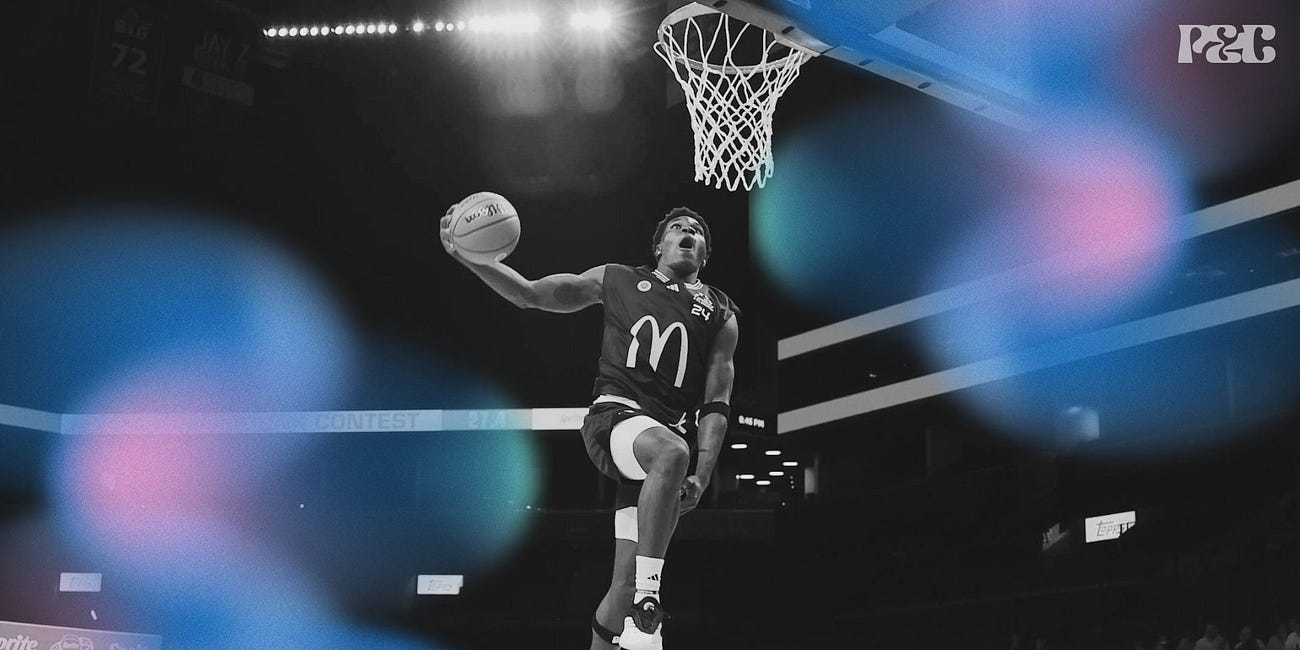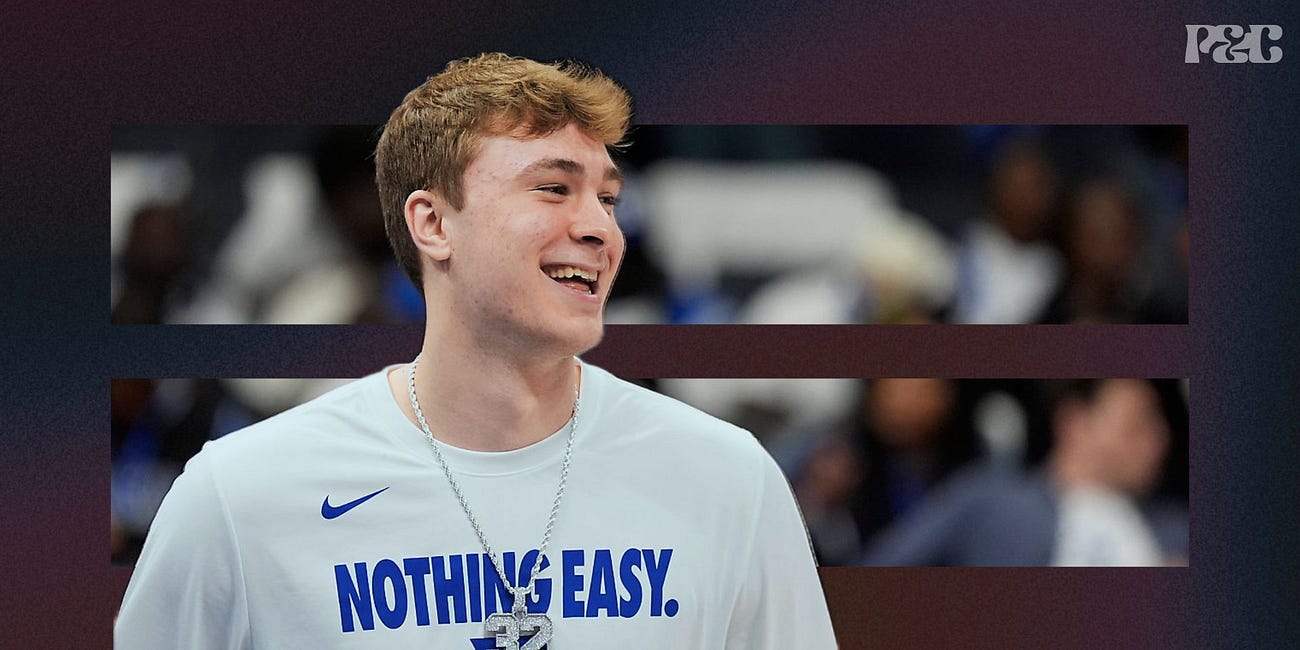The false philosophy of Ace Bailey
The 6-foot-9 Rutgers standout has received top-three hype the entire cycle. That hype seems blind to his many damning weaknesses.
There’s a certain level of, “OK, I get it,” in my reaction to the poetic that has been waxed regarding Rutgers forward Ace Bailey. The 6-foot-10*, 200-pound 18-year-old is one of the easiest players to convince yourself of in this class through his highlight reel alone.
His following, which includes whoever it may be at the head of just about every mainstream NBA Draft outlet, is convinced Bailey is a top-three — top-five minimum — pick, and their case typically revolves around three observations.
Bailey is long and undeniably fluid. I put an asterisk next to his height above because I think he’s probably a bit closer to 6 feet 8 inches without shoes, but it’s still huge for his size and role. Add a 7-foot wingspan on top of that, and it all starts to look slightly Durant-esque.
With players of Bailey’s aesthetic, flashes take precedence. The Durant-esque-ness previously stated has become a cliché for bigger wings and lanky forwards who like to pull up with a hand in their face, but every once in a while, those flashes look like something sustainable. I have my gripes with that takeaway.
The fallacy of potential. Age, size and a superstar example that looks vaguely similar are often what categorizes potential in the mainstream. Bailey is young, he’s big, and as mentioned, he’s constantly trying to imitate his inspirations.
On top of that, Bailey was a high school sensation. For a lot of one-and-done’s, the narratives and hype surrounding them coming out of grassroots ball carries over, for better or worse. For Bailey, it was for the better.
The idea and narrative of what Bailey is or could be has been the leading factor in him carrying his top-three hype into May, and likely into June and July. However, for Bailey, the lesser-spoken weaknesses, in reality, have been crippling to his ability to properly utilize his skill set, realizing that idea of what he could be.
There is a product there, but it’s not the one being sold. By all likelihood, what we’re looking at with Bailey isn’t an on-ball superstar or a shot-making maestro, but something a little more condensed and nuanced. The unlikelihood with which he reaches that is tied to several contradictions within his tools and skillsets, which have been damning to his projection as a top pick, but understanding those contradictions paints a picture of what Bailey should reasonably be rather than what he hypothetically could be.
MORE
Starting with Bailey’s tools, which out of high school were the most remarkable part of his profile, there’s been a certain level of nullification at the collegiate level. He’s certainly capable of getting up, as evidenced by arguably the best highlight of the year in the 2023-24 high school season.
Enough of that nullification is explained through his shot profile. Of the 440 shots Bailey took in his single collegiate season, just 53 were at the rim in the half-court, with just 14 dunks. On top of that, Bailey notched a 56.6% field goal percentage on those 53 attempts. Compare that to his teammate, Dylan Harper, who’s four-to-five inches shorter, and shot nearly 10 percent better on almost 100 more attempts.
This lack of proficiency and efficiency both in getting to and finishing at the rim is the first link in the damning chain of weaknesses that lead me to be low on Bailey. Athletically, his open-space verticality is the singular trait I’d dub elite, but lacking high-end strength and burst has limited the easy shots he should be able to generate.
The one area he’s looked great scoring downhill is against slower, or clumsy-footed big men who aren’t as advanced of lateral movers as Bailey is. He toasted some of the Big Ten’s best bigs — Trey Kaufman-Renn, Nate Bittle and Danny Wolf to name a few — on baseline drives, often finishing with a Kobe-esque reverse jam, using the rim as a shot-blocking deterrent.
However, when attacking these same players in help defense, or simply trying to iso against a wing, Bailey’s shortcomings as a handler, athlete and finisher were on full display. He was often tied up, blocked or left flailing against a stronger body as the line to the basket wasn’t cleared for takeoff.
The next disconnect in the Bailey chain is the handle itself. It’s the primary deterrent keeping Bailey from getting to the rim the way he should be able to.
Despite a good bit of lateral wiggle, Bailey’s handle is objectively loose, and adding to that with an inability to win with strength, Bailey’s often forced into difficult pull-ups off the dribble. Bailey’s shot is difficult to block with his length and mechanics, but his inability to create space by allowing the defense to dictate where he shoots from makes the shots he takes extremely difficult.
This is often conflated with flashes of shot-creation, but Bailey doesn’t create anything for himself on these looks. Rutgers’ roster creation gave Bailey the leeway to play through these clearly benchable shots.
There’s also the issue of Bailey’s shooting itself. Bailey possesses a pretty shooting stroke, with a high release making it visibly difficult to contest, but the consistency is wildly lacking.
He made 32.8% of his dribble jumpers, including just 24.2% of his pull-up 3’s. Additionally, he shot just 69.2% from the free-throw line. Volume alone projects him as an above-average shooter, but it may be more in the Jimmy Butler vein than the Kevin Durant one. Someone who makes shots, but will never be classified as an elite shooter.
BIG BOARD
2025 NBA Draft Big Board 6.0
The NCAA Tournament has nearly concluded, meaning only the prospects on the best teams are still putting film on the table. While most of the attention is deservedly shown to the games currently playing, the brevity between actions gives way to plenty of time to catch up on the players no longer out there.
The path to success is simplifying Bailey’s role and limiting his shot profile. He’s an excellent cutter who can get above the rim easily when he’s found with space under the rim, and much better on catch-and-shoot looks (shot 38.7% on 93 catch-and-shoot 3-pointers).
Potential as an off-ball weapon is abundant in Bailey’s profile, especially if the shot actually does come true. Oftentimes, players who handle the usage of Bailey tend to develop those nuanced offensive skills necessary for great positioning, spacing and movement from a team standpoint.
On top of that, Bailey has the skill set of a solid defensive piece. While offensively, he fits as a three or four most comfortably, defensively, he’s at his best sitting on the backline wiping away shots at the rim. For a wing, Bailey’s 1.3 blocks per game is abundantly impressive.
Fastening him to a weaker offensive player in the corner, letting him see the whole court, reading and reacting to drives, cuts and passes have been where he thrives. He has an undeniable knack for covering ground and has been effective at wiping away transition opportunities as well.
He’s not without his weaknesses there as well, however. Ace’s technique and versatility on the ball is lacking compared to his skills on the weak side of the rim, and his awareness isn’t always all the way there.
Despite this, there’s a role for Bailey. It’s not the Durant-style scoring superstar scouts tend to typecast tall wings with a proclivity for low-quality jumpers, but, in a refined role with a good coach and the right surrounding pieces, Bailey can be a valuable piece, despite the contradictions that exist within his game.





Loved the deep dive, I think those who are high on him find it easy to talk themselves to that star potential. The flaws are concerning for him to be that highly touted, but like you said there’s a middle ground for him to carve himself a quality role/career in the league.
Anyone who is still that high on him is anchoring to his high school scouting report... he's more of a project than anyone wants to believe